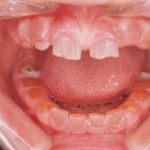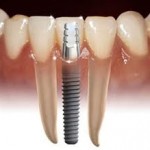Dentinogenesis imperfecta is an inherited disorder of the dentine affecting the primary and permanent dentitions. It can be associated with a medical condition which is known as Osteogenesis imperfecta. Continue reading
Tag Archives: Dentinogenesis imperfecta
Dental care for osteogenesis imperfecta patients Part 3
Other Treatments
Dental Implants are used to replace missing teeth. Theoretically it is possible to do this successfully for a person with OI and there is anecdotal evidence that this has been accomplished. However, there are no controlled studies on the use of dental implants in people with OI and only a few case reports in the literature. The high failure, reported to be 50 per cent within 3 years of surgery is a concern.
Dental implants are somewhat like screws. In order to function, there must be enough bone in the jaw for the implant to be securely placed. After healing, a “post†is placed in the implant and an artificial tooth is attached. Good, strong healing around the implant is critical. Continue reading
Dental care for osteogenesis imperfecta patients Part 2
General Care for People With OI Plus DI
Children with OI and dentinogenesis imperfecta need the same basic care as discussed in Part 1, but they also need to be monitored for cracking, chipping and abrasion of the teeth. Special care will be needed even with the baby teeth. All of the teeth may not be affected by DI, and primary teeth usually are affected to a greater extent than the permanent teeth. Restorative treatment may be needed at some point. Continue reading
Dental care for osteogenesis imperfecta patients Part 1
Osteogenesis imperfecta (OI) is always associated with bone fragility. In addition, OI may affect the growth of the jaws and may or may not affect the teeth. About half of the people who have OI have teeth that appear normal, and their major concerns are routine care. However, the other half has a defect in the teeth called dentinogenesis imperfecta (DI), sometimes referred to as opalescent teeth or brittle teeth. These teeth may be misshapen, may chip or break easily, and will require special care. Continue reading
Non Carious/Decayed Lesion
1.Attrition
2.Abrasion
3.Erosion
4.Abfraction lesions
5.Localized non-hereditary Enamel Hypoplasia
6.Localized non-hereditary Enamel Hypocalcification
7.Localized non-hereditary Dentin Hypoplasia
8.Localized non-hereditary Dentin Hypocalcification
9.Discolorations
10.Malformations
11.Amelogenesis imperfecta
12.Dentinogenesis imperfecta
13.Trauma

